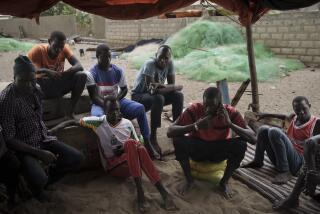Life Among the Nomads of Africa
- Share via
WIND, SAND & SILENCE: Travels With Africa’s Last Nomads, text and photos by Victor Englebert (Chronicle Books, $35 hardcover).
The Belgian-born Englebert, a self-taught naturalist and anthropologist, lived and traveled with various nomadic tribes in Africa between 1965 and 1991, and this is a record of his experiences. The images of bush and desert life are often stunning--camel-borne Tuaregs emerging from the dunes in indigo robes and sunglasses, members of a Danakil tribal council posed frieze-like with their rifles, Bororo dancers dressed and made up for a festival in a style that seems more Indonesian than African. Englebert’s text is sometimes surprising (the Danakil, in Eritrea and Djibouti, mine salt from desert salt pans and harvest sharks from the Red Sea for the Chinese shark-fin market, which hardly seem like nomadic pursuits) and sometimes harrowing (the author treks Lawrence-of-Arabia-style across burning sands--the lake he is approaching is a mirage--and he is nearly killed several times by anti-Ethiopian guerrillas).
Elsewhere, his experiences are downright poetic. In one passage, he gives a flirtatious 12-year-old Danakil girl an orange. “She has never seen one before,” he writes, “so I show her how to eat it. She likes it very much, and when she has swallowed the last piece and wiped her mouth with the back of her hand, she improvises a short song which she repeats several times: “The red man has given me an orange/The red man is a good man.” But the caravan has started up again. . . .”
IRAN by David St. Vincent (Lonely Planet, $14.95 paper).
If ever a destination seems to call for a “Travel Survival Kit” (as all Lonely Planet guides are blurbed) it is Iran--posturing, hostage-taking, war-torn, anti-Western. The word “survival” might well, in this case, be taken literally. Indeed, you might ask, why would a traveler today--especially an American, a citizen of the country widely denounced in Iranian rhetoric as “the Great Satan”--want to go to Iran in the first place?
Author St. Vincent offers several good reasons: Friendly people (on an unofficial level, at least), reasonable prices, stunning landscapes and, perhaps most of all, “a magnificent cultural legacy entirely unspoiled by tourism.”
Though the country officially opened its doors to tourism two years ago, he notes, obtaining a visa can still be a time-consuming and frustrating process. And while U.S. citizens, he writes, “have recently been allowed in much more easily than before . . . only those with a very cogent reason for visiting (are accepted).” And he admits that certain kinds of travelers won’t find it much fun if they do get in: Visitors are held to Islamic behavioral codes (women have to be particularly careful) and Westerners are banned from many hotels. And don’t even ask about night life. “What does the foreigner do for evening entertainment in Iran?” St. Vincent asks. One suggestion: “Get out that novel you’ve always been meaning to read.” Presumably, said novel had better not have scantily clad damsels on the cover.
BRAZIL by Andrew Draffen, Robert Strauss and Deanna Swaney, 2nd edition (Lonely Planet, $17.95 paper); and ECUADOR & THE GALAPAGOS ISLANDS by Rob Rachowiecki, 3rd edition (Lonely Planet, $16.95 paper).
Updated editions of the Lonely Planet guides to two destinations of a more accessible sort, these new volumes are typical of the series--comprehensive, easily readable, eminently practical. Particularly fascinating is a 32-page Galapagos wildlife guide in the Ecuador book.
More to Read
Sign up for our Book Club newsletter
Get the latest news, events and more from the Los Angeles Times Book Club, and help us get L.A. reading and talking.
You may occasionally receive promotional content from the Los Angeles Times.










